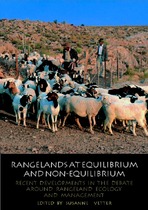Rangelands at equilibrium and non-equilibrium recent developments in the debate around rangeland ecology and management
Date
2003Author
Bayer, Wolfgang
Hahn, Brian
Hiernaux, Pierre
Hoffman, Timm
Illius, Andrew
Kerven, Carol
O’Connor, Tim
Richardson, David
Sandford, Stephen
Vetter, Susanne
Ward, David
Waters-Bayer, Ann
Metadata
Show full item recordAbstract
The debate on equilibrium vs non-equilibrium dynamics
in pastoral systems emerged in the early 1980s, when
economists, ecologists and social scientists began to
challenge the widespread claims of overgrazing and
degradation in African rangelands and subsequent
interventions based on rangeland succession theory and
correct stocking rates (for example, Sandford 1982;
1983; Homewood & Rodgers 1987; Ellis & Swift 1988;
Abel & Blaikie 1989; Westoby et al. 1989). The debate
gained momentum in the early 1990s after two
international workshops around emergent new paradigms
in rangeland ecology and socio-economics
(Woburn I and II), which resulted in the publication of
two books, Range Ecology at Disequilibrium edited by
Behnke et al. (1993) and Living with Uncertainty edited by
Scoones (1994). The ‘new rangeland ecology’ argued that
the traditional, equilibrium-based rangeland models did
not take into account the considerable spatial heterogeneity
and climatic variability of semi-arid rangelands,
and that mobility, variable stocking rates and adaptive
management were essential for the effective and
sustainable utilisation of semi-arid and arid rangelands.

